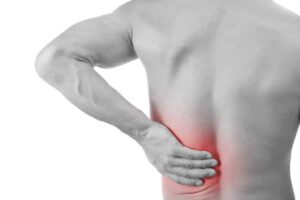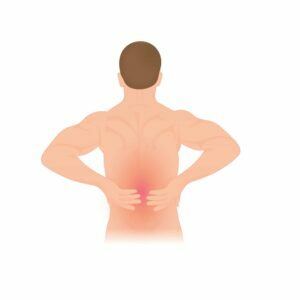Managing Low Back Disc Injuries
At our chiropractic clinic, each week we see people suffering from pain from disc injuries. These patients have often looked things up on Google and perhaps have been confused by all the information out there. The aim of this post is to help explain how to manage low back disc injuries. In short, for someone with a disc injury seeing a chiropractor can be very helpful as part of the package of care.
Low Back Pain and Disc Injuries
The image that comes to mind when thinking of low back pain is a person half-bent over with a hand on the sore spot of their back. Many of us have experienced low back pain, and you may recall feeling severely limited or even helpless during the acute phase of your last episode. Feelings of pain and helplessness are some of the reasons why low back pain is one of the most common causes for patients to seek emergency care(1)!

In fact, over 80% of people have experienced at least one episode of low back pain in their lives, and up to a quarter of adults have experienced low back pain in the last three months(2,3)! That’s pretty… painful to think about, actually.
On top of this, chronic low back pain is considered the second most common form of disability worldwide(3) and one of the most common causes for adults to see a family physician (4).
In the past, patients were told to “take it easy” during a flare-up of low back pain. They may have been prescribed bed rest by their family physician, thinking that avoidance of movement would help relax spasming muscles and ease pain to more tolerable levels.
However, times have changed. Treatment guidelines instead recommend specific exercise (4), gentle stretches, and other ways of staying active during the recovery process. Total bed rest is to be avoided.
Why the change?
Part of the reasoning is anatomical. Two types of muscles exist in our backs: superficial muscles (or surface muscles) and deep muscles (5).
Superficial muscles are used to perform motions like bending and twisting. These muscles are strengthened by exercise that places stress on the muscles. Think of the person at the gym lifting weights: they’re building and growing these superficial muscles.
Deep muscles, on the other hand, help stabilize the spine and maintain posture. Physical activity such as yoga, walking, and more, helps keep them in shape. Picture the jogger going for a mile or two before breakfast: they’re working on deep muscle strength.
Common Back Pain Scenario
A common scenario is bending over to pick something off the floor. You may hear or feel a “pop” in your low back, followed by pain and muscle tightness. You’re bent over, unable to fully stand upright, and your back suddenly hurts no matter what you do. You go to bed – and stay there, unable to move because movement equals pain. You call out of work because you can’t get out of bed. You remain largely sedentary for a week, under the guise of “waiting it out.”

When a person goes on lengthy bed rest, the deep muscles in the back will weaken and begin to lose mass and strength. This is a process known as atrophy (6).
As the pain subsides and the person feels some improvement, activity is slowly resumed. In order to do this, the body will recruit the bending, twisting, superficial muscles to help stabilize the back. Although they can function in this capacity, superficial muscles are NOT well-adapted for this function! These superficial muscles will tire more easily, resulting in impaired normal movement or motor control.
This can place abnormal stress on the structures in the spine such as joints and muscles, as well as joints and muscles in other areas of the body, increasing the risk for additional musculoskeletal injuries (7,8).
There are specific exercises that help strengthen the stabilizing muscles that lie deep in our bodies, close to the spine. Doctors of chiropractic regularly prescribe exercises to address an acute flare-up of low back pain and may suggest general activities, such as swimming or walking, to improve your overall fitness (8).
Exercises For Low Back Disc Pain
Some specific exercises, known as McKenzie exercises, are especially effective for patients who are suffering from an intervertebral disc injury (4). “McKenzie exercises” is a term you may not be familiar with. Yet. But hang with me. They have become a staple in the conservative management of low back pain. They entail simple exercises that have very profound impacts on a patient’s low back pain. They are named after Robin McKenzie, the physical therapist who first began using them.
McKenzie exercises are designed to be used after a thorough evaluation from your medical practitioner. In fact, McKenzie refers to a method of mechanical diagnosis and series of therapeutic exercises prescribed based on the determined diagnosis. The exercises I will be teaching here are simply one protocol of McKenzie exercises. It is the most commonly followed protocol; however, it will not help every low back pain patient. This is also not a substitute for a mechanical examination. Instead it is a tool for patients in acute pain seeking relief until obtaining professional care.
Lower Back Disc Injuries
In their most basic form, McKenzie exercises are most effective for patients suffering from intervertebral disc injuries. Disc injuries can cause a variety of low back symptoms from intense back pain to pain radiating into a lower extremity. These exercises may reduce the intensity of the pain and in some patients, eliminate it completely.
When you are experiencing a disc bulge or herniation, the disc material will often protrude posteriorly. While there are other kinds of disc injuries, these are the most common. Disc injuries are extremely prevalent in today’s population. Many who seek medical care for these injuries will be told their options are rest or surgery. The body has the ability resorb the disc naturally, although in some severe cases surgery is necessary. McKenzie exercises are a mechanical tool that patients can use to help the body resorb this disc.
McKenzie extension exercises work because they force the spine to go into an extended position (when referencing the lumbar spine this means an “arched” back position). This arch will actually cause the two vertebrae to close down over the disc at the posterior aspect. This “closing” of the disc space can actually cause the protruding disc material to retract back into the spine and relieve many of the symptoms associated with a lumbar spine disc injury.
Before performing these exercises there are a few things you should pay attention to:
While performing the exercises it is common to experience pain throughout the exercise. Often after multiple repetitions the pain intensity will begin to decrease. If you perform the exercises and the pain gets worse and stays worse these exercises may not be right for you.
If you are experiencing symptoms into your lower extremity, these exercises may also help reduce those symptoms. As you perform repetitions, pay attention to the intensity of the pain in your leg. Has it been improving? Does the pain travel as far as it did when you began? If either of these occur continue with more sets and repetitions. These exercises may be right for you. It should be noted that even if symptoms in the lower extremity begin to trace back up the leg or decrease, it is not uncommon to simultaneously have increased pain in the low back. It sounds counterintuitive, but increased back pain is not always a bad sign when the pain in your leg is improving. Typically, when there is radiating pain in the lower extremity, to get rid of the pain completely (from the leg AND back) the leg pain must be eliminated first. While performing these exercises, we often see the pain tracing up the leg towards the back becoming more intense, but over a smaller surface area. The smaller the area of pain, regardless of intensity, the closer you are to abolishing it completely.
How do we perform these exercises?
You can begin these exercises in a standing or prone (on your stomach) position. When standing you will put your hands at the base of your spine and drive your hips forward. The goal is to push your hips over your toes or past them. Take the stretch to the point of pain or until you are unable to go any further and repeat.
If you are on your stomach, keep your hips on the floor and bring your hands up to your chest as if you are doing a push up. Push your chest up, going as far as you can without lifting your hips. If you are in a lot of pain, you may only move a couple inches. Do not force yourself through the pain. Let each repetition gradually improve your range through these exercises.
You can see a demonstration of the above exercise at the 20 seconds mark in this video:
A good place to start is with 3 sets of 10 repetitions. If the pain increases after three sets, it may not be the right exercise for your condition. If you experience no change or even mild improvement, perform more repetitions to see if you can create lasting improvement. For many patients these exercises may not only help decrease overall pain but also are useful for mitigating flare ups.
Remember these are just one of many different types of McKenzie exercises. You may require a different direction or progression of exercises. This is a great place to start if you are on your own but remember – it is highly recommended to get a proper evaluation from a McKenzie practitioner to determine exactly which exercises will treat your individual ailment.
I hope you have found this post helpful and informative. If you would like to keep up to date with our other posts, remember to follow us on Facebook and Instagram.
References
Casiano, V.E., and De, N.K. (2020). Back pain. StatPearls. StatPearls Publishing: 2020 Jan.
“Back pain fact sheet.” (2014). National Institute of Neurological Disorders and Stroke. Retrieved March 2020 from: https://www.ninds.nih.gov/Disorders/Patient-Caregiver-Education/Fact-Sheets/Low-Back-Pain-Fact-Sheet
Allegri, M., et al. (2016). Mechanisms of low back pain: a guide for diagnosis and therapy. F1000Research, 5, F1000 Faculty Rev-1530.
Casazza, B. (2012). Diagnosis and treatment of acute low back pain. Am Fam Physician; 85(4): 343-350.
Netter, F. (2011). Atlas of human anatomy. Philadelphia, PA: Saunders/Elsevier.
Dirks, M.L., et al. (2016). One week of bed rest leads to substantial muscle atrophy and induces whole-body insulin resistance in the absence of skeletal muscle lipid accumulation. Diabetes 65; (10):2862-75.
Belavy, D.L., et al. (2007). Superficial lumbopelvic muscle overactivity and decreased contraction after 8 weeks of bed rest. Spine 32(1), E23-E29.
“Low back pain.” (2020). American Academy of Family Physicians. Retrieved from https://familydoctor.org/condition/low-back-pain.




